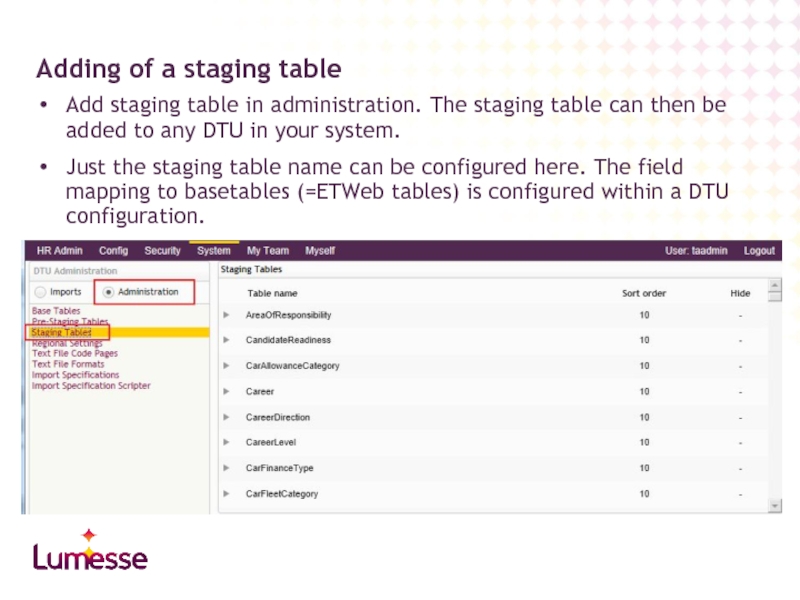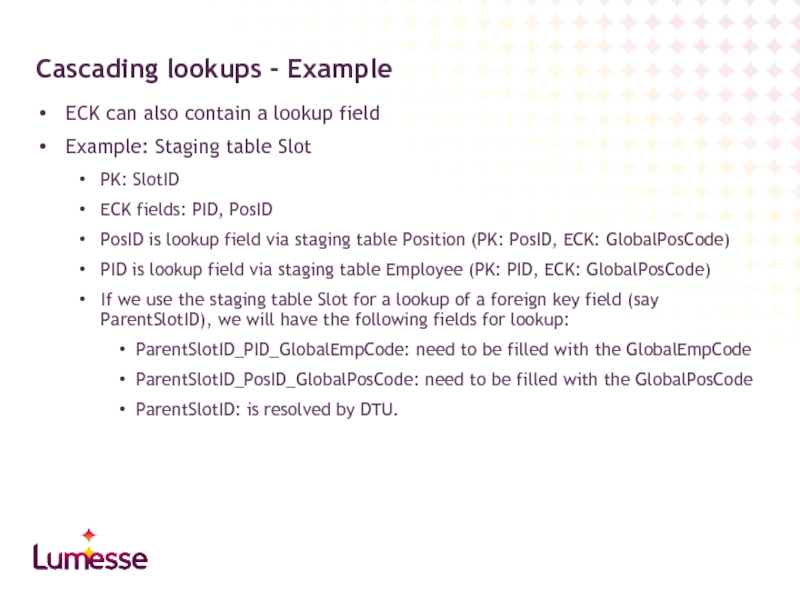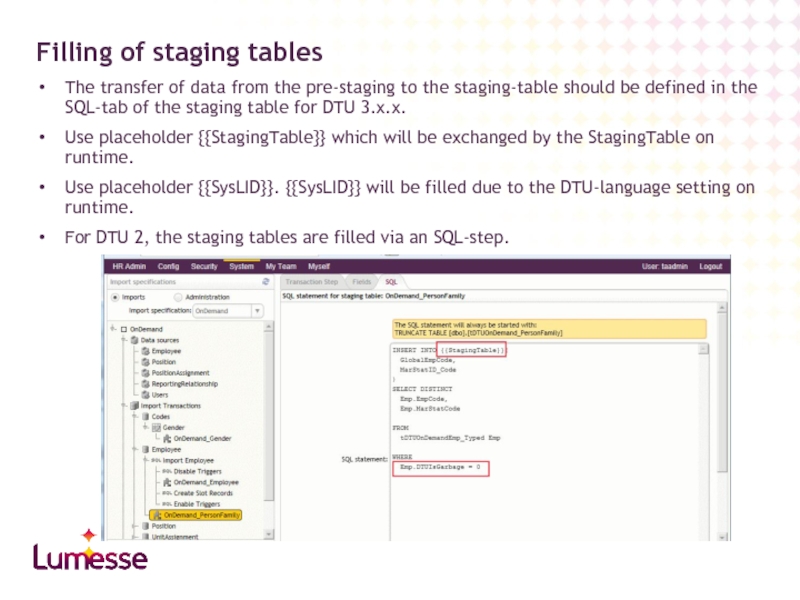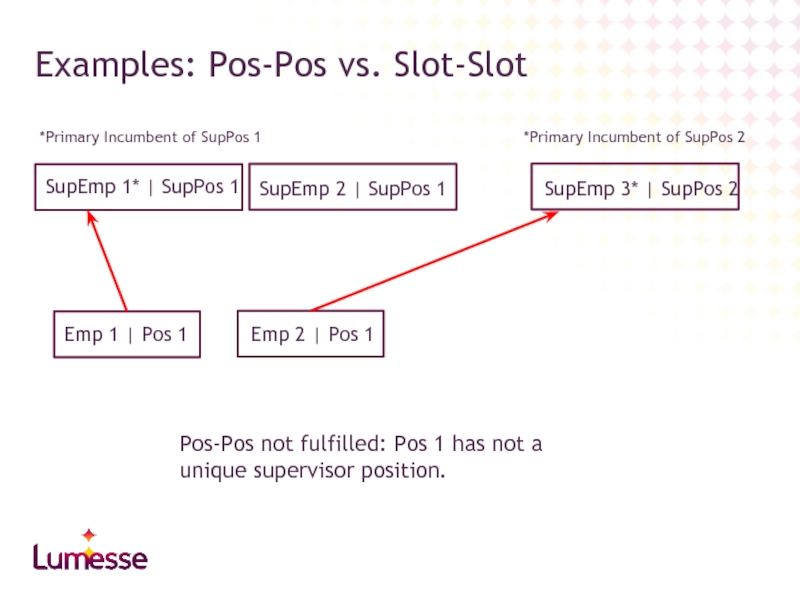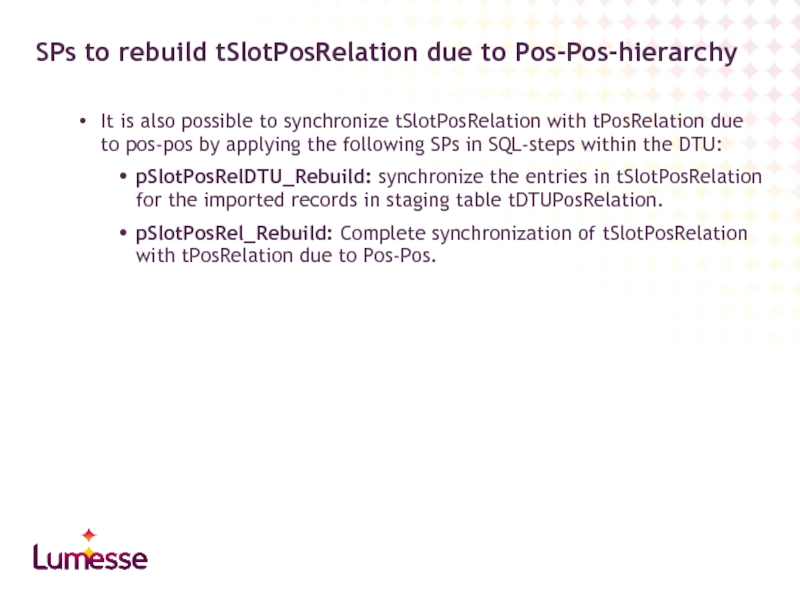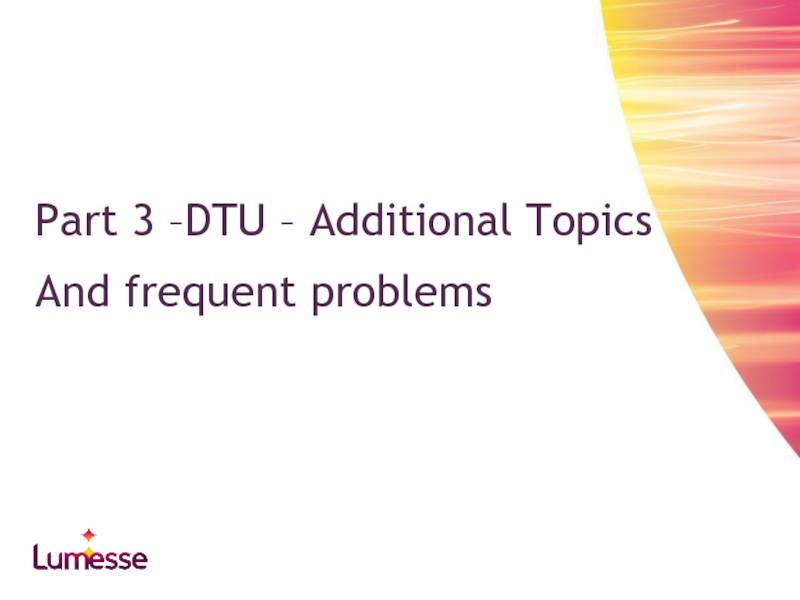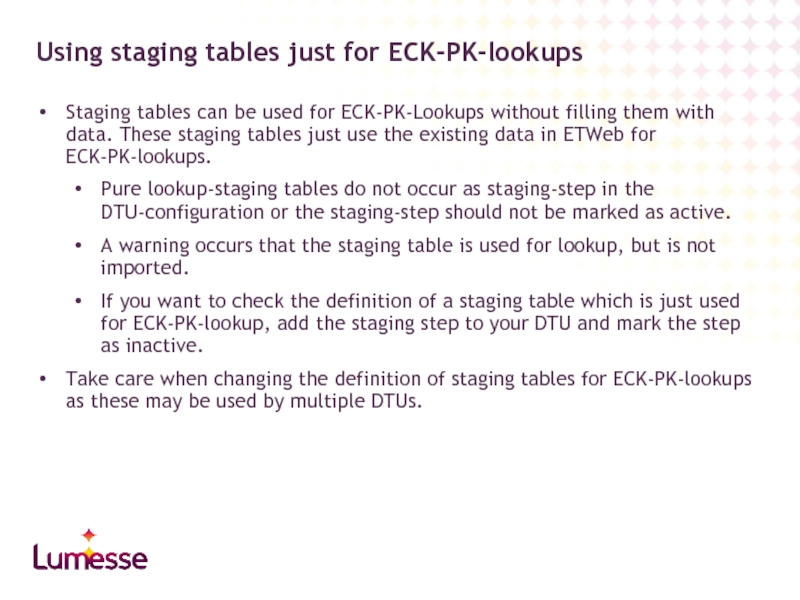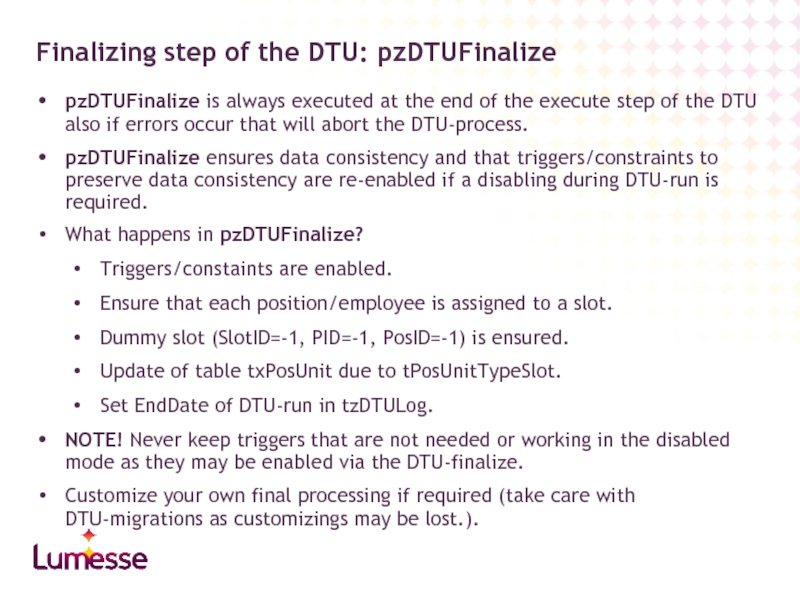- Главная
- Разное
- Дизайн
- Бизнес и предпринимательство
- Аналитика
- Образование
- Развлечения
- Красота и здоровье
- Финансы
- Государство
- Путешествия
- Спорт
- Недвижимость
- Армия
- Графика
- Культурология
- Еда и кулинария
- Лингвистика
- Английский язык
- Астрономия
- Алгебра
- Биология
- География
- Детские презентации
- Информатика
- История
- Литература
- Маркетинг
- Математика
- Медицина
- Менеджмент
- Музыка
- МХК
- Немецкий язык
- ОБЖ
- Обществознание
- Окружающий мир
- Педагогика
- Русский язык
- Технология
- Физика
- Философия
- Химия
- Шаблоны, картинки для презентаций
- Экология
- Экономика
- Юриспруденция
DTU – Data Transfer Untility Training презентация
Содержание
- 1. DTU – Data Transfer Untility Training
- 2. Agenda DTU –Introduction DTU – A detailed
- 3. Part 1: DTU - Introduction
- 4. One-way-transfer from external data into ETWeb Import
- 5. ETWeb Wiki DTU and TP: Get Latest
- 6. DTU.exe requires .NET-Framework (3.5, some older versions
- 7. DTU versions are different from ETWeb versions
- 8. Migration to a new main version (i.e.
- 9. Part 2: DTU – A detailed view
- 10. Import Steps Raw
- 11. Step 1: Raw data from the
- 12. Transfer the data from the pre-staging table
- 13. Pre-Staging tables and Staging tables are generated
- 14. Pre-Staging and Staging tables are created in
- 15. Add new pre-staging table in Administration. Just
- 16. Link raw data source to pre-staging table
- 17. Mapping of raw data fields to (typed)
- 18. Add staging table in administration. The staging
- 19. A basetable (=Ausgangstabelle in German) is a
- 20. Updates/Inserts from staging table data into the
- 21. BE VERY CAREFUL! A staging table can
- 22. Purpose 1: Import data Definition of the
- 23. Imported data and data in the basetable
- 24. PK-field (PK = primary key) of the
- 25. Staging tables define mapping of a PK
- 26. Our previous example: Staging tables: Employee Foreign-Key-Field:
- 27. ECK can also contain a lookup field
- 28. Special field for staging table to indicate
- 29. One staging-table can map to various basetables
- 30. The transfer of data from the pre-staging
- 31. DTU 3.x.x: The steps within a transaction
- 32. BE CAREFUL! Look at transaction Employee: SQL-statements
- 33. Additional fields of pre-staging or staging table
- 34. Available for DTU 3.x.x Compose a validation
- 35. Slot Assignment via DTU
- 36. Contraints: Each employee/position is assigned to one
- 37. Check “Process as: Slot table”: The import
- 38. pzDTUSlotHandling assumes a staging table tDTUSlot
- 39. Imports slots from tDTUSlot into tSlot.
- 40. DTU 2.0 DTU-SlotHandling-SP is always pzDTUSlotHandling.
- 41. Hierarchy import via DTU
- 42. ETWeb allows multiple hierarchies. In all
- 43. Pos-Pos-Hierarchy: Each position has one
- 44. Examples: Pos-Pos vs. Slot-Slot
- 45. Examples: Pos-Pos vs. Slot-Slot
- 46. Examples: Pos-Pos vs. Slot-Slot
- 47. Examples: Pos-Pos vs. Slot-Slot
- 48. Show/hide the right frontends to maintain
- 49. Two hierarchy tables exist in ETWeb:
- 50. The DTU samples (Standard, OnDemand) import
- 51. Imports from tDTUPosRelation into tPosRelation. Synchronizes
- 52. It is also possible to synchronize
- 53. DTU 2.0 DTU-PosRelation-SP is always pzDTUPosRelation.
- 54. OrgUnit-Assignment via DTU
- 55. Check „Unit Assignment table“ on the
- 56. The unit fields of the staging
- 57. Pre-Staging-Step Staging-Step PK/ECK for identifying records
- 58. Part 3 –DTU – Additional Topics And frequent problems
- 59. Typical execution command for DTU: DTU.EXE
- 60. Connection is specified in DTU.exe.config:
- 61. Take care with the setting Allow
- 62. May be useful and time-saving as
- 63. Take care that pre-staging tables or
- 78. Final Questions/Discussions
Слайд 2Agenda
DTU –Introduction
DTU – A detailed view
DTU-Walkthrough
Special Processing (Slots, Hierachies,
DTU – Additonal topics and frequent problems
Слайд 4One-way-transfer from external data into ETWeb
Import is not integrated into ETWeb,
Configuration and Logging via ETWeb-Frontend
Import via DTU
DTU.exe
Datafiles: CSV, XLS
Database
Слайд 5ETWeb Wiki
DTU and TP: Get Latest Version - Download various DTU-versions
Search Wiki for DTU for introductions and various articles about DTU issues and versions.
Partner Site
Where to get the DTU.exe, sample configurations and further information?
Слайд 6DTU.exe requires .NET-Framework (3.5, some older versions 2.0)
Configuration in DTU.exe.config (especially
DTU.exe needs access to ETWeb-Database
Regular run is configured via ETWeb task processor or as schedules windows task.
DTU.exe can run on a machine which is different from the SQL-server
For Excel-Import, Microsoft.Jet.OLEDB.4.0 need to be accessible.
Configuration and Requirements
Слайд 7DTU versions are different from ETWeb versions
Version history
DTU 2
Still in use
DTU 3
Published with ETWeb 10.6, but can be also used with older versions of ETWeb from ETWeb 10.3 onwards (however unofficially).
Language-dependent lookups have been changed.
Added real SQL-transactions.
Compatibility-mode with DTU 2.
Only data changes will be imported.
DTU 3.5.x
performance issues for huge amounts of import data have been solved
Can be used for ETWeb 10.6 onwards.
DTU Versions
Слайд 8Migration to a new main version (i.e. 2 -> 3 or
Apply of a DTU migration updater for changing to a new main version (Wiki page DTU and TP: Get Latest Version: https://devwikis.lumesse.com/ETWebWiki/DTU%20Get%20Latest%20Version.ashx)
Check the differences of the DTU versions and if they affect your DTU configuration. Important issues with migrating 2 -> 3 or 2 -> 3.5 may be:
Transaction issues
Order of execution
Language dependence of lookups
Proper testing of the DTU with the new version is required.
Migration of DTU version
Слайд 10
Import Steps
Raw Data Files (CSV, XLS)
tDTU...._Typed
tDTU..._Untyped
tDTU...
Pre-Staging
Staging
Слайд 11
Step 1: Raw data from the datasources is written into the
Step 2: Untyped data is casted into typed fields:
Validation of data-formats.
Optional validation of required fields.
Optional validation that a field value(s) is/are unique within the records.
Configuration in DTU-section Data sources
Pre-Staging-Step
Слайд 12Transfer the data from the pre-staging table to the staging table.
Resolving
Applying further T-SQL-statements.
Updating and Inserting the data into the ETWeb-Tables (also called „Basetable“ or „Ausgangstabelle“ in DTU) via the configured staging table-basetable mapping (puzzle piece).
Configuration in DTU section Import Transactions
Staging-Step
Слайд 13Pre-Staging tables and Staging tables are generated due to the DTU-configuration
Pre-Staging
Untyped pre-staging tables: postfix _untyped
Typed pre-staging tables: postfix _typed
Examples:
DTU-Configuration: Pre-Staging-Table Employee will generate database tables
tDTUEmployee_Untyped
tDTUEmployee_Typed
DTU-Configuration: Staging-Table Employee will generate database tables
tDTUEmployee
Namings of Pre-Staging Tables/Staging Tables
Слайд 14Pre-Staging and Staging tables are created in the build-step of the
Pre-Staging-Tables and Staging-Tables can be used in SQL-statements executed during the DTU-run. (take care with ID-fields, see later)
It is common to configure the DTU to remove pre-staging and staging tables after import. For debugging and verification it is possible to keep the DTU-table-data after the import.(Setting: Empty staging tables after import)
DTU-version 3 onwards: The content of pre-staging and staging tables are archived for the latest DTU runs. (Setting: Maximum number of logs)
Pre-Staging Tables/Staging Tables during DTU-processing
Слайд 15Add new pre-staging table in Administration.
Just name of pre-staging is booked
Adding Pre-Staging Table
Слайд 16Link raw data source to pre-staging table
BE CAREFUL! The pre-staging table
Configuration of Pre-Staging
Слайд 17Mapping of raw data fields to (typed) pre-staging fields
BE CAREFUL! The
Configuration of Pre-Staging fields
Слайд 18Add staging table in administration. The staging table can then be
Just the staging table name can be configured here. The field mapping to basetables (=ETWeb tables) is configured within a DTU configuration.
Adding of a staging table
Слайд 19A basetable (=Ausgangstabelle in German) is a link to an ETWeb
Dropdown provides all ETWeb tables
NOTE! If the ETWeb-table is a 1:1-sub-table where entries are generated via a trigger, never forget the check 1:1 table.
Adding of a Basetable (=link to ETWeb table)
Слайд 20Updates/Inserts from staging table data into the basetable is defined via
NOTE! The field names need to be the names of the fields in the basetable. The field types also refer to the basetable. You cannot have additional fields in the staging table that do not refer to a basetable field!
Configure staging table fields (1)
Слайд 21BE VERY CAREFUL! A staging table can be shared among various
Configure staging table fields (2)
Слайд 22Purpose 1: Import data
Definition of the fields that are transferred to
Definition of the rule how to identify imported records with records that may already exist in ETWeb and just need to be updated.
Purpose 2: Defining lookup rules for filling foreign key fields
Definition of the rule how to lookup foreign key via imported fields.
Note! A staging table can also be used just for one purpose.
How do we identify imported records and fields with existing data in ETWeb?….Let’s talk about PKs and ECKs.
Multipe purposes of staging table mappings
Слайд 23Imported data and data in the basetable is identified via one
Note that also multiple fields can build an ECK.
If one record in the staging table and basetable matches due to ECK, there will be an UPDATE.
If no corresponding record is found in the basetable, we have an INSERT.
If there are multiple records in the staging table with the same ECK, just the first record will be imported. For DTU 3 or higher this behaviour can be change via configuration (
If one record of the staging table matches to multiple records in the basetable due to the ECK, just one record in the basetable will be updated and no error is reported (verified for DTU 3.5.3).(The DTU may be too generous here. Take care!)
ECK-Field (= External Combined Key)
Слайд 24PK-field (PK = primary key) of the staging table corresponds to
Staging Table defines a mapping between a PK-field (ID in ETWeb) and the ECK-field which can be also used for ID-Lookups for foreign keys
The PK-fields of the staging tables are filled during processing the import of the basetable if a record could be identified via ECK. (Be Save! Avoid using PK-fields of staging tables in DTU-SQL-statements. In some DTU-versions (i.e. 3.5) the PK-field is still NULL when you SQL-statement is executed.).
PK-Field (= Primary Key)
Слайд 25Staging tables define mapping of a PK (=primary key) to an
If we check “Auto add missing lookups” and have an ECK that does not exist in the basetable of StatusEmp, the ECK will be added to the basetable.
Lookup of foreign keys
Слайд 26Our previous example:
Staging tables: Employee
Foreign-Key-Field: StatusEmpID
Staging-table for lookup: StatusEmp
ECK: Code
PK: StatusEmpID
DTU
StatusEmpID: will be set by the DTU via ECK-PK-lookup of staging-table StatusEmp.
StatusEmpID_Code: Additional lookup field. Need to be filled with ECK from the imported data.
In general, the additional lookup-field has the name [Fieldname]_[ECK-Fieldname]. If we have a ECK with multiple fields, we have multiple lookup fields.
NOTE! A missing foreign-key-lookup will just result into a warning. The record is still imported.
Lookup of foreign keys - Example
Слайд 27ECK can also contain a lookup field
Example: Staging table Slot
PK: SlotID
ECK
PosID is lookup field via staging table Position (PK: PosID, ECK: GlobalPosCode)
PID is lookup field via staging table Employee (PK: PID, ECK: GlobalPosCode)
If we use the staging table Slot for a lookup of a foreign key field (say ParentSlotID), we will have the following fields for lookup:
ParentSlotID_PID_GlobalEmpCode: need to be filled with the GlobalEmpCode
ParentSlotID_PosID_GlobalPosCode: need to be filled with the GlobalPosCode
ParentSlotID: is resolved by DTU.
Cascading lookups - Example
Слайд 28Special field for staging table to indicate that the table contains
ECK is the Code plus the SysLID which is set due to the DTU-language setting.
DTU 2: Fallbacks to the default language are not included in the lookup. The code need to exist in the DTU-language.
DTU 3.x.x: Fallbacks to the default language are included in the lookup.
NOTE! Never change the language setting of a DTU that is in use already. Especially when you use the AutoAdd-feature for missing lookup values this can create inconsistent data in code tables.
Staging table – SysLID field
Слайд 29One staging-table can map to various basetables when they have a
Staging table with fields from different basetables
Слайд 30The transfer of data from the pre-staging to the staging-table should
Use placeholder {{StagingTable}} which will be exchanged by the StagingTable on runtime.
Use placeholder {{SysLID}}. {{SysLID}} will be filled due to the DTU-language setting on runtime.
For DTU 2, the staging tables are filled via an SQL-step.
Filling of staging tables
Слайд 31DTU 3.x.x: The steps within a transaction are really executed in
Most important to know and most confusing! The SQL-steps in the tabs of a staging table are always executed first and before the transaction.
Process Order
Слайд 32BE CAREFUL! Look at transaction Employee: SQL-statements of the puzzle pieces
Process Order - Example
Слайд 33Additional fields of pre-staging or staging table for errors and warnings:
DTUIsGarbage:
DTUGarbageText: error or warning message
Fields DTUIsGarbage, DTUGarbageText can set and filled via SQL-statements in the DTU, however you should be aware of the process order in order to set the DTUIsGarbage-Flags early enough.
Fields for errors and warnings
Слайд 34Available for DTU 3.x.x
Compose a validation SQL-statement out of the staging
Row message will turn out to be the DTUGarbageText.
Validation step need to be before the staging step (=puzzle piece).
Validation steps
Слайд 36Contraints:
Each employee/position is assigned to one or more slots.
Each employee has
Each position has exactly one primary employee within the position’s incumbents.
Special position/employee for vacant positions/unassigned employees:
PosID = -1: artificial position “Unassigned”
PID = -1: artificial employee “Vacant”
Triggers of tSlot preserve the constraints
Employee – Position – Assignment (Slot)
Слайд 37Check “Process as: Slot table”: The import of the staging table
pzDTUSlotHandling additionally write internal work history entries for unassignments if “Create Internal Work History record” is checked.
Triggers of tSlot are disabled during the operation of pzDTUSlotHandling. The SlotHandling cares about the contraints (primary flags) of tSlot-data.
DTU-SlotHandling
Слайд 38
pzDTUSlotHandling assumes a staging table tDTUSlot with the following fields which
PID: configured as a lookup field on staging table Employee (with generated ECK-lookup-field PID_GlobalEmpCode for the standard DTU).
PosID: configured as a lookup field on staging table Position (with generated ECK-lookup-field PosID_GlobalPosCode).
IsPrimaryEmp: employee is primary incumbent of the position.
IsPrimaryPos: position is primary position of the employee.
DTUUnassign: if set to 1, the employee is unassigned from old positions if he/she is assigned to a new position.
DTUHierID: if set to -1 (=direct hierarchy), the supervisor slot of the direct hierarchy is set corresponding to the primary incumbent of the supervisor position.
DTU-SlotHandling: pzDTUSlotHandling
Слайд 39
Imports slots from tDTUSlot into tSlot.
Unassign employee from old assignments that
Write entry in internal work history if „Create Internal Work History Records“ is checked.
Adjust the flags IsPrimaryEmp and IsPrimaryPos due to the contraints (one primary employee per position, one primary position per employee).
If there is a conflict due to multiple primary employees/positions from the imported data, the latest slot gets the primary flag.
Synchronize the slot-slot-hierarchy due to the pos-pos-hierarchy for imported slots. The supervisor slot is the primary incumbent of the supervisor position (see later).
pzDTUSlotHandling: What happens?
Слайд 40
DTU 2.0
DTU-SlotHandling-SP is always pzDTUSlotHandling.
DTU 3.x
Default DTU-SlotHandling-SP is pzDTUSlotHandling, but other
Delievered DTU-SlotHandling-SPs for the samples of DTU3.x:
pzDTUOnDemand_SlotHandling: uses staging table tDTUOnDemand_Slot instead of tDTUSlot.
pzDTUStandard_SlotHandling: copy of default pzDTUSlotHandling to be used with the standard DTU-sample.
DTU-SlotHandling for DTU 2.0 and DTU 3.x
Слайд 42
ETWeb allows multiple hierarchies. In all hierarchy tables, we have a
Default hierarchies:
Direct hierarchy: PosHierID = -1
Functional hierarchy: PosHierID = -2
Hierarchies in ETWeb
Слайд 43
Pos-Pos-Hierarchy:
Each position has one (or none) supervisor position as a
The supervisor of a position’s incumbant is the primary incumbant of the supervisor position.
For most companies, a pos-pos-hierarchy is sufficient and the easiest to maintain.
Only one incumbant per position means always Pos-Pos.
Slot-Slot-Hierarchy:
Each slot has one (or none) supervisor slot as a parent slot.
The slot-slot-hierarchy is more flexible. The incumbants of one position can have different supervisors on different positions. It is not required that the supervisor is always the primary incumbant of a position.
The slot-slot-hierarchy is far more complex and difficult to maintain. If you assign a person to a position, the supervisor and supervisor position needs to be assigned manually.
IMPORTANT! A consultant must clarify which hierarchy should be used. It is not possible to mix up the hierarchy concepts in one ETWeb.
Pos-Pos- vs. Slot-Slot-Hierarchy – Functional Concept
Слайд 44Examples: Pos-Pos vs. Slot-Slot
Emp 1 | Pos 1
Emp 2 | Pos
SupEmp 1* | SupPos 1
SupEmp 2 | SupPos 1
* Primary Incumbent of SupPos 1
OK: Pos-Pos fulfilled
Слайд 45Examples: Pos-Pos vs. Slot-Slot
Emp 1 | Pos 1
Emp 2 | Pos
SupEmp 1* | SupPos 1
SupEmp 2 | SupPos 1
*Primary Incumbent of SupPos 1
Pos-Pos not fulfilled: Supervisor of Emp 2 on Pos1 is not primary incumbant.
Слайд 46Examples: Pos-Pos vs. Slot-Slot
Emp 1 | Pos 1
Emp 2 | Pos
SupEmp 1* | SupPos 1
SupEmp 2 | SupPos 1
*Primary Incumbent of SupPos 1
Pos-Pos not fulfilled: Pos 1 has not a unique supervisor position.
SupEmp 3* | SupPos 2
*Primary Incumbent of SupPos 2
Слайд 47Examples: Pos-Pos vs. Slot-Slot
Emp 1 | Pos 1
Emp 2 | Pos
SupEmp 1* | SupPos 1
SupEmp 2 | SupPos 1
*Primary Incumbent of SupPos 1
OK: Pos-Pos fulfilled. Note that an employee can have more than one supervisor (Emp 2). For each position a different one.
SupEmp 3* | SupPos 2
*Primary Incumbent of SupPos 2
Emp 2 | Pos 2
Слайд 48
Show/hide the right frontends to maintain hierarchies:
Pos-Pos-Hierarchy:
PosSupervisor.asp
PosSubordinate.asp
Slot-Slot-Hierarchy:
SlotSupervisor.asp
SlotSubordinate.asp
NOTE! In ETWeb 10.x, the
Pos-Pos- vs. Slot-Slot-Hierarchy – Frontends
Слайд 49
Two hierarchy tables exist in ETWeb:
tPosRelation: PosID, ParentPosID, PosHierID
tSlotPosRelation: SlotID, ParentSlotID,
Pos-Pos-hierarchy:
Both table are used. If tPosRelation is updated or positions are assigned/unassigned, the entries in tSlotPosRelation are kept synchonized due to the pos-pos-relation. (Supervisor is the primary incumbent of the parent position.)
Slot-Slot-hierarchy:
Just tSlotPosRelation is used. tPosRelation will be empty.
NOTE! If you need to retrieve a supervisor, do not use tPosRelation, but tSlotPosRelation as this will allow to extend pos-pos to slot-slot later on.
Pos-Pos- vs. Slot-Slot-Hierarchy – Tables
Слайд 50
The DTU samples (Standard, OnDemand) import pos-pos-hierarchies.
Pos-Pos-Hierarchy: Check “Position relation table”
The import and special processing is then done a PosRelation-handling-SP pzDTUPosRelation (default). Do not forget this check as the hierarchy data will not be processed properly otherwise.
Imports of slot-slot-hierarchies requires extensions and modifications of the standard DTU.
DTU-Import of hierarchies
Слайд 51
Imports from tDTUPosRelation into tPosRelation.
Synchronizes tSlotPosRelation with tPosRelation due to pos-pos
Required fields in tDTUPosRelation:
PosID: configured as a lookup field on staging table Position(with generated ECK-lookup-field PosID_GlobalPosCode for the standard DTU).
ParentPosID: configured as a lookup field on staging table Position(with generated ECK-lookup-field ParentPosID_GlobalPosCode for the standard DTU).
PosHierID: hierarchy (direct or functional usually)
PeerOrder
Comment
pzDTUPosRelation: What happens?
Слайд 52
It is also possible to synchronize tSlotPosRelation with tPosRelation due to
pSlotPosRelDTU_Rebuild: synchronize the entries in tSlotPosRelation for the imported records in staging table tDTUPosRelation.
pSlotPosRel_Rebuild: Complete synchronization of tSlotPosRelation with tPosRelation due to Pos-Pos.
SPs to rebuild tSlotPosRelation due to Pos-Pos-hierarchy
Слайд 53
DTU 2.0
DTU-PosRelation-SP is always pzDTUPosRelation.
DTU 3.x
Default DTU-SlotHandling-SP is pzDTUPosRelation, but other
Delivered DTU-PosRelation-SPs for the samples of DTU3.x:
pzDTUOnDemand_PosRelation: uses staging table tDTUOnDemand_PosRelation instead of tDTUPosRelation
pzDTUStandard_SlotHandling: copy of default pzDTUSlotHandling to be used with the standard DTU-sample
pzDTUPosRelation3: improved version of pzDTUPosRelation; obsolete transaction has been removed.
DTU-PosRelation-Handling for DTU 2.0 and DTU 3.x
Слайд 55
Check „Unit Assignment table“ on the staging table for Position-Unit-Assignment which
Triggers on tPosUnitTypeSlot and tUnit/tUnitText need to be disabled. The special unit-processing of the DTU replaces the functionality of the triggers which are synchronizing txPosUnit with tPosUnitTypeSlot.
DTU-Import of Position-OrgUnit-Assignment
Слайд 56
The unit fields of the staging table for Pos-Unit-Assignment usually have
Select the unit type of the unit from the dropdown and check „Process as unit assignment“
If you import an assignment to a sub-unit, you also need to have the assignments to the parent units in the same staging table.
Missing units will be added if „Auto add missing unit“ is checked.
Lookup-Fields for Units
Слайд 57
Pre-Staging-Step
Staging-Step
PK/ECK for identifying records
Loopup-fields
SysLID-field
Process order
Validations, Errors, Warnings, Logging
Special Processing
SlotHandling
PosRelation-Handling
Assignment of organisation
Summary - Part 2
Слайд 59
Typical execution command for DTU:
DTU.EXE /DTUCfgID=1 /build /import /execute
Parameters:
/DTUCfgID=: ID of
/build: Staging and Pre-Staging tables are created.
/import: Pre-Staging-Tables are populated from data sources.
/execute: Import transactions of the DTU are executed. (Transferring data to staging tables, import of staging tables, additional SQL-steps, validations)
It is possible to run just single steps for analyzing purposes.
Running DTU and DTU steps
Слайд 60
Connection is specified in DTU.exe.config:
Connection with Integrated Security:
Windows user who executes the DTU.exe needs access to ETWeb-database.
Connection with SQL-server security
NOTE! For old versions (DTU 2), UserID and Password are not specified in the connection string, but added as run parameters: /uid, /pwd
DTU.EXE /DTUCfgID=1 /build /import /execute /uid=sa /pwd=subscribe
Connection with ETWeb database
Слайд 61
Take care with the setting Allow NULL overwrite!
This setting can be
RULE: If you do not populate a field with data, it is important to deactivate the field for the import. DO NOT FORGET AND CHECK PROPERLY!
BE CAREFUL: Allow NULL overwrite
Слайд 62
May be useful and time-saving as it is not required to
Take care to adjust the language setting properly! You will arrive at multiple code table entries with the same functional meaning otherwise.
You can just import in one language if using this feature. Never simply change the language setting of a DTU that is already running even. If a consultant may ask for it, explain the problems that this will cause.
BE CAREFUL: Auto add lookup values and language setting
Слайд 63
Take care that pre-staging tables or staging tables can be used
If you want to change pre-staging tables or stagings tables just for your DTU, you need to create a copy. Copy-SQLs are available via Wiki:
https://devwikis.lumesse.com/ETWebWiki/copy%20a%20staging%20table.ashx
https://devwikis.lumesse.com/ETWebWiki/copy%20a%20pre-staging%20table.ashx
You need to make sure that all SQL-statements in the DTU refer to the copied table. Also think about the Slot-Handler-SP or PosRelation-Handler-SP.
BE CAREFUL: Multiple use of pre-staging/staging tables
Слайд 64
Take care about transactions and processing order
Note that DTU-transactions-steps in
Note that the SQL-statements in the tab of the staging tables (puzzle pieces) are run before the DTU-transaction and are not included in the DTU-transaction.
Take care if you call a stored procedure. If the stored procedure includes a transaction which is rolled back due to an error, the whole DTU-transaction will be rolled back.
Bad example from the real world: A stored procedure call is embedded into BEGIN TRY….END TRY with empty CATCH.
An error occurred in the stored procedure. Due to BEGIN TRY … END TRY the error did not appear in the DTU-log.
The whole DTU-transactions-step was rolled back due to the rollback in the stored procedure. Later it turned out that the data was incorrect.
Слайд 65
BE AWARE: Required field setting in pre-staging table
Required-setting for pre-staging-fields
Field need to occur in the data source.
Field need to be filled.
NOTE! If a pre-staging-field is not set as required and the column is missing in the import file, the field will be generated but left empty. Just a warning in the log occurs.
Check log warnings about missing and additional fields carefully and regularly and advice the consultant to forward to the customer.
Слайд 66
Update DTU-Audit when changing data via SQL-steps
DTU-Audit in Import Summary
Displays the numbers of records in the pre-staging tables/staging tables which are imported with the number of records with warnings/errors.
Displays the number of imported/updated records in basetables.
All staging-records which are set as garbage before the staging step are included in the error/warning count automatically.
DTU-Audit is updated just by the Built-In-DTU-steps (PreStaging-Step, Staging-Step, Validation-step). If you apply changes on data in SQL-steps which may affect the counts in the audit, you need to consider to update the DTU-audit via SQL yourself:
tzDTUAuditPreStagingData
tzDTUAuditStagingData
tzDTUAuditTableData
Слайд 67
Using staging tables just for ECK-PK-lookups
Staging tables can be used
Pure lookup-staging tables do not occur as staging-step in the DTU-configuration or the staging-step should not be marked as active.
A warning occurs that the staging table is used for lookup, but is not imported.
If you want to check the definition of a staging table which is just used for ECK-PK-lookup, add the staging step to your DTU and mark the step as inactive.
Take care when changing the definition of staging tables for ECK-PK-lookups as these may be used by multiple DTUs.
Слайд 68
Finalizing step of the DTU: pzDTUFinalize
pzDTUFinalize is always executed at
pzDTUFinalize ensures data consistency and that triggers/constraints to preserve data consistency are re-enabled if a disabling during DTU-run is required.
What happens in pzDTUFinalize?
Triggers/constaints are enabled.
Ensure that each position/employee is assigned to a slot.
Dummy slot (SlotID=-1, PID=-1, PosID=-1) is ensured.
Update of table txPosUnit due to tPosUnitTypeSlot.
Set EndDate of DTU-run in tzDTULog.
NOTE! Never keep triggers that are not needed or working in the disabled mode as they may be enabled via the DTU-finalize.
Customize your own final processing if required (take care with DTU-migrations as customizings may be lost.).
Слайд 69
Known problem with 1:1-basetables
Bug in versions 3.5.1/3.5.2: Data fields of
Bug is fixed in 3.5.3
You have the same effect when you miss the 1:1-setting on basetables refering to 1:1 tables. This also occurs occasionally and causes confusion about fields which remain empty. Please check carefully!
Слайд 70
Issues on validations
DTU 3.x: it is recommended to use new
Validation in SQL-steps:
Add customized validations to staging-table records and not pre-staging-table records.
Records with errors: Set DTUIsGarbage=1 plus the DTUGarbageText for records which should not be imported in the staging step.
Records with warnings: Set DTUGarbageText for records which should still be imported in the staging step, but have a warning in the DTU-log.
It is obvious that you need to validate the records before the staging step and after populating the staging table. Remember the processing order here: If you implement the filling of the staging table in the SQL-Tab of the staging table (puzzle piece), this step will be executed before any other step of the corresponding DTU-transaction.
Слайд 71
DTU.exe.config for DTU 3.x
Configure SP for SlotHandling
Configure SP for
Configure Log-Levels (Critical, Error, Warning, etc.) for DTU-logs. DTU-Logs are written into:
DTU-Log-tables in database
DTU-Console
Textfile DTU.log
Configure timeout for populating pre-staging tables.
Configure notify mail about DTU-executions with success or error message.
Слайд 72
DTU.exe.config: Additional settings for 3.5.3
true: records in
false: the first record within the non-unique records is imported; others are marked as garbage and are not imported (default before 3.5.3).
true: records in the staging table which are not unique due to the ECK are marked as garbage and are not imported.
false: the first record of the non-unique is imported; others are marked as garbage and are not imported (default before 3.5.3).
NOTE! The InvalidateDuplicateECK-check just refer to imported records. If a staging table record would refers to multiple records in the ETWeb-basetable via ECK, just the first basetable record will be updated. Check your ECK-setting very properly as you will not be notified about multiple records that fit!
A text value “NULL” is not interpreted as database-NULL. (default: false)
Слайд 73
Issues to clarify
Format of the imported data:
CSV or XLS (always
Field names
Encoding of the text files
Field separators
Text qualifiers (if delimiter should be contained in the text), escape character for text qualifier
Formatting of date values and decimal values
Import language: Especially important if Auto-Adds of codes and org. units should be used.
It need to be absolutely clear if the customer uses pos-pos-hierarchies or slot-slot-hierarchies.
Lookups of codes/units: Auto-Add is activated or not? Do not decide that yourself!
ECKs need to be clear.
Required fields need to be clear.
Sample files with filled fields are available on project start?
Responsibility for additional technical support (support of technical consultant available?).
Execution of DTU via task processor, manual or by windows task processor? (support of technical consultant available?)
Слайд 74
Why are DTU issues sometimes detected so late?
People just focus
This symbol just means that the DTU has execute all steps without abortion. BUT it does not mean that everything is in order! The DTU-log need to be checked additionally on each DTU-run:
Check records with warnings and errors in pre-staging and staging tables.
Check warnings indicating missing and additional fields in the import data.
Check warnings for those staging tables which are not populated but used for lookup. Is that ok?
QA DTU before delivery: Verify the imported data field by field.
Make very sure that the file paths for the data sources point to the right file if the customer/consultant are coming up with issues. (Yes, such things may occur...)
Слайд 75
DTU in ETWeb-Migrations
How does it work?
Define data sources of type
Fill the typed pre-staging tables from the source database.
Use IDs of source database as ECKs. You need to add these ID-fields to the destination database tables.
Take care about different collations from source database and destination databases when comparing strings. (Use COLLATE)
Souce DB
Destination DB
tDTU..._Typed
DTU-Processing
ETWeb-Tables
ETWeb-Tables
Transfer data to DTU-tables
Слайд 76
DTU in ETWeb-Migrations
Advantages
No need to program foreign-key-lookups yourself.
DTU-processing for multiple
Migration can be run multiple times and update records. Corrections are possible and the migration process can be smooth.
Migration of data of DTU versions with very different data models (9 -> 11).
Disadvantages
More programming effort than a migration script. You always need to program two steps (filling of pre-staging table, filling of staging table)
Consider issues due to multiple languages carefully (especially with the Auto-Add-feature of codes and units).
Customers with DTU-migration: Bayer, Kaufhof
Слайд 77
Summary of fequent mistakes
Errors due to lack of awareness of
Missing setting for 1:1-tables.
SlotHandling/PosRelation handling is not configured properly and/or understood properly.
Inadequate use of primary key fields of the staging tables for joining data. For inserted records, these fields remain Null for some versions. Better to be save to avoid using these fields.
Adjustments of staging-tables/pre-staging tables are done without awareness that they may be used by other DTUs as well.
DTUs are scripted partially. NOTE that all DTUs need to be scripted for any DTU-delivery.
No clearness in the Pos-Pos/Slot-Slot-issue.
Truncation of staging tables are missing.
Problems due to wrong or changed language setting.
Log details are ignored.
ECK is not really uniquely identifying records or configured wrong.
Fields that are not filled are configured as active in the staging table configuration (with Allow Null overwrite).

















